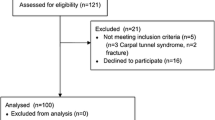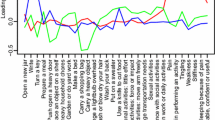Abstract
The aim of this paper is to analyze the relation between components of disability with distinguished score of impairment, activity and participation questionnaire based on clinical data of persons with hand injuries. Impairment was evaluated by use of AMA guide 6th edition and disability by DASH questionnaire on Convenience sample of patients (N = 117), with chronic hand injuries. Linking and allocating items of the DASH were done based on the ICF Core Set for Hand Conditions and the opinions of a group of experts from different related fields. Data was analyses by using Kappa index, Chi square test and a set of Pearson, Part and Partial correlations coefficient. Most of the DASH items were allocated to the activity; one to four of the items could not be classified and 0 to 22 were classified as having overlap. Participation and activity scores correlated positively with each other (r > 0.80). Impairment had high correlation with activity and participation scores (>73). With controlling the effect of each or both construct, this relation between them with impairment diminished but still significant between activity and impairment. There is a huge overlap in definition of activity and participation. The most effecting item in relation of disability and impairment is activity restriction. Participation had no relation with impairment.
Similar content being viewed by others
References
Gustafsson M, Ahlstram G (2004) Problems experienced during the first year of an acute traumatic hand injury‚ Äìa prospective study. J Clin Nurs 13(8):986–995
Rondinelli RD, Genovese E, Brigham CR (2008) Guides to the evaluation of permanent impairment: American Medical Association
Lindenhovius AL, Buijze GA, Kloen P, Ring DC (2008) Correspondence between perceived disability and objective physical impairment after elbow trauma. J Bone Joint Surg 90(10):2090–2097
Adams J, Burridge J, Mullee M, Hammond A, Cooper C (2004) Correlation between upper limb functional ability and structural hand impairment in an early rheumatoid population. Clin Rehabil 18(4):405–413
Farzad M, Asgari A, Dashab F, Layeghi F, Karimlou M, Hosseini SA, Rassafiani M (2015) Does disability correlate with impairment after hand injury?. Clin Orthop Relat Res®:1–7
Jette AM (2006) Toward a common language for function, disability, and health. Phys Ther 86(5):726–734
Seelman K. Trends in rehabilitation and disability: transition from a medical model to an integrative model. In: National Rehabilitation Conference Keynote Tokorozawa, Japan: National Center for Persons with Disabilities Retrieved November: 2003; 2003: 2004
World Health Organization WHO (2001) International classification of functioning disability and health (ICF)
Mij G (2001) International classification of functioning, disability and health (ICF)
Salter K, Jutai J, Teasell R, Foley N, Bitensky J, Bayley M (2005) Issues for selection of outcome measures in stroke rehabilitation: ICF activity. Disabil Rehabil 27(6):315–340
Kus S, Oberhauser C, Cieza A (2012) Validation of the brief international classification of functioning, disability, and health (ICF) core set for hand conditions. J Hand Ther
Dixon D, Johnston M, McQueen M (2008) The Disabilities of the Arm, Shoulder and Hand Questionnaire (DASH) can measure the impairment, activity limitations and participation restriction constructs from the International Classification of Functioning, Disability and Health (ICF). BMC Musculoskelet Disord 9(1):114
Eberhardt K, Fex E (1995) Functional impairment and disability in early rheumatoid arthritis--development over 5 years. J Rheumatol 22(6):1037
Chapman TT, Richard RL, Hedman TL, Renz EM, Wolf SE, Holcomb JB (2008) Combat casualty hand burns: evaluating impairment and disability during recovery. J Hand Ther 21(2):150–159
ICF W (2001) International classification of functioning, disability and health. In: World Health Organization, Geneva. 3–25
Fowler D, French P, Hodgekins J, Lower R, Turner R, Burton S, Wilson J (2013) CBT to address and prevent social disability in early and emerging psychosis. CBT for Schizophrenia: Evidence-Based Interventions and Future Directions :143–167
Bot S, Terwee C, Van der Windt D, Bouter L, Dekker J, De Vet H (2004) Clinimetric evaluation of shoulder disability questionnaires: a systematic review of the literature. Ann Rheum Dis 63(4):335–341
Hudak PL, Amadio PC, Bombardier C, Beaton D, Cole D, Davis A, Hawker G, Katz JN, Makela M, Marx RG (1996) Development of an upper extremity outcome measure: the DASH (Disabilities of the Arm, Shoulder, and Head). Am J Ind Med 29(6):602–608
Chen C, Granger C, Peimer C, Moy O, Wald S (2005) Manual Ability Measure (MAM-16): a preliminary report on a new patient-centred and task-oriented outcome measure of hand function. J Hand Surg: Br Eur 30(2):207–216
Gandek B, Sinclair SJ, Jette AM, Ware JE Jr (2007) Development and initial psychometric evaluation of the participation measure for post-acute care (PM-PAC). Am J Phys Med Rehabil 86(1):57–71
Janda DH, Geiringer SR, Hankin FM, Barry DT (1987) Objective evaluation of grip strength. J Occup Environ Med 29(7):569–571
Jebsen RH, Taylor N, Trieschmann R, Trotter M, Howard L (1969) An objective and standardized test of hand function. Arch Phys Med Rehabil 50(6):311
Robinson JP, Turk DC, Loeser JD (2004) Pain, impairment, and disability in the AMA guides. J Law Med Ethics 32(2):315–326
Spieler EA, Barth PS, Burton JF Jr, Himmelstein J, Rudolph L (2000) Recommendations to guide revision of the guides to the evaluation of permanent impairment. JAMA: J Am Med Assoc 283(4):519–523
Rondinelli RD (2009) Changes for the new AMA Guides to impairment ratings: implications and applications for physician disability evaluations. PM&R 1(7):643–656
Blais BR, Association AM (2011) AMA guides to the evaluation of ophthalmic impairment and disability: measuring the impact of visual impairment on activities of daily life. American Medical Association
Hudak PL, McKeever PD, Wright JG (2004) Understanding the meaning of satisfaction with treatment outcome. J Bone Joint Surg Am 15
Mousavi SJ, Parnianpour M, Abedi M, Askary-Ashtiani A, Karimi A, Khorsandi A, Mehdian H (2008) Cultural adaptation and validation of the Persian version of the Disabilities of the Arm, Shoulder and Hand (DASH) outcome measure. Clin Rehabil 22(8):749–757
Cohen J, Cohen P, West SG, Aiken LS (2013) Applied multiple regression/correlation analysis for the behavioral sciences. Routledge
Whiteneck G, Dijkers MP (2009) Difficult to measure constructs: conceptual and methodological issues concerning participation and environmental factors. Arch Phys Med Rehabil 90(11):S22–S35
Mink van der Molen ABEA, Hovius SER (2003) Outcome of hand trauma: the hand injury severity scoring system (HISS) and subsequent impairment and disability. Hand Surg 28B:285–299
André M, Hagelberg S, Stenström CH (2004) The juvenile arthritis foot disability index: development and evaluation of measurement properties. J Rheumatol 31(12):2488–2493
Slim FJ, van Schie CH, Keukenkamp R, Faber WR, Nollet F (2010) Effects of impairments on activities and participation in people affected by leprosy in The Netherlands. J Rehabil Med 42(6):536–543
Fougeyrollas P (1995) Documenting environmental factors for preventing the handicap creation process: Quebec contributions relating to ICIDH and social participation of people with functional differences. Disabil Rehabil 17(3–4):145–153
Cardol M, Jong BAD, Ward CD (2002) On autonomy and participation in rehabilitation. Disabil Rehabil 24(18):970–974
Heinemann AW, Tulsky D, Dijkers M, Brown M, Magasi S, Gordon W, DeMark H (2010) Issues in participation measurement in research and clinical applications. Arch Phys Med Rehabil 91(9):S72–S76
Brown M, Dijkers MP, Gordon WA, Ashman T, Charatz H, Cheng Z (2004) Participation objective, participation subjective: a measure of participation combining outsider and insider perspectives. J Head Trauma Rehabil 19(6):459–481
Pollard B, Johnston M, Dieppe P (2011) Exploring the relationships between International Classification of Functioning, Disability and Health (ICF) constructs of Impairment, Activity Limitation and Participation Restriction in people with osteoarthritis prior to joint replacement. BMC Musculoskelet Disord 12(1):97
Nagi SZ (1991) Disability concepts revisited: implications for prevention. Disability in America: toward a national agenda for prevention :309–327
Jette AM, Haley SM, Kooyoomjian JT (2003) Are the ICF activity and participation dimensions distinct? J Rehabil Med 35(3):145–149
Whiteneck G (2008) A conceptual and practical solution for differentiating activity and participation in the ICF. In: 14th Annual North American Collaborating Center Conference on ICF “Evaluating Social Participation: Applications of ICF & ICF-CY”, Quebec, Canada, August: 2008
Franchignoni F, Giordano A, Sartorio F, Vercelli S, Pascariello B, Ferriero G (2010) Suggestions for refinement of the Disabilities of the Arm, Shoulder and Hand Outcome Measure (DASH): a factor analysis and Rasch validation study. Arch Phys Med Rehabil 91(9):1370–1377
Acknowledgments
The authors are very thankful to Dr. David Ring, M.D. Ph.D. Associate Professor of Orthopedics Surgery, Harvard Medical School, Chief, Hand and Upper Extremity Service of Massachusetts general hospital, (Gale Whiteneck, PhD, FACRM - Senior Principal Investigator, Diane Dixon, PhD of Psychology, University of Stirling, Scotland, UK).
Conflict of Interest
The authors declare that they have no conflict of interest.
Ethical Approval
All procedures performed in studies involving human participants were in accordance with the ethical standards of the institutional and/or national research committee and with the 1964 Helsinki declaration and its later amendments or comparable ethical standards. This article does not contain any studies with animals performed by any of the authors.
Informed Consent
Informed consent was obtained from all individual participants included in the study.
Declaration of Interest
There is no deceleration on interest for this work and the authors also don’t report any declaration of interest.
Author information
Authors and Affiliations
Corresponding author
Rights and permissions
About this article
Cite this article
Farzad, M., Asgari, A., Layeghi, F. et al. Exploring the Relation Between Impairment Rating by AMA Guide and Activity and Participation Based on ICF in the Patients with Hand Injuries. J Hand Microsurg 7, 261–267 (2015). https://doi.org/10.1007/s12593-015-0197-z
Received:
Accepted:
Published:
Issue Date:
DOI: https://doi.org/10.1007/s12593-015-0197-z




